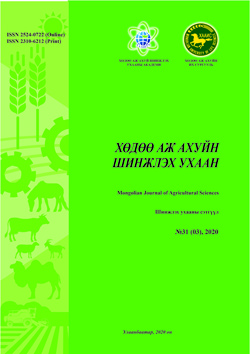The Study on helminths of wild animal
DOI:
https://doi.org/10.5564/mjas.v31i3.1530Keywords:
Wild sheep, Ibex, Wild horse (Equus ferus przewalskii), migratory birds, feacal sample, egg, oocystAbstract
During the study for biodiversity of wild mammals and their parasite and infectious agents, there have more risky to get natural hotspots due to global warming, huge number of domesticated animals and deficiency of pasture in Mongolia.
Therefore, a major concern of researchers and rangers is survey to ascertain parasites of wild animals, particularly parasitism of migratory birds.
We used to the study totally 224 feacal samples of wild animals, including 96 wild sheep, 101 ibex, 53 wild goose and 24 wild horse.
The study results, found by helminth fauna of 7 genera such as Paramphistomum spp, Moniezia spp, Neoascaris sрp, Trichostrongylus spр, Nematodirus sрp, Haemonchus spp, Trichuris spp, belonging to 3 main classes of helminthes and Coccidia spp protozoa in feacal samples of mountain sheep and the 5 genera of helminthes such as Paramphistomum spp, Moniezia spp, Neoascaris sрp, Nematodirus sрp, Trichuris spp and protozoa Coccidia spp in feacal samples of ibex. The Paramphistomum spp have been found in mountain sheep and ibex for the first time in Mongolia.
The floatation method of feacal egg determination, shown that nematode infection of Ascaridae and Strongylidae in wild horses. The egg of Capillaria spp and oocyst of Eimeria spp in feces of swan goose and the eggs of two genera of nematode (Ascaridae spp, Capillaria spp) and oocyst of Eimeria spp in feces of grey goose were found in the study.
The parasite fauna in feacal samples of certain wild host animals was considered by the prevalence of infection in Mongolia.
Зэрлэг амьтдын гельминтийн судалгаа
Цаг агаарын дулаарал, мал сүргийн тооны өсөлт, бэлчээрийн хомсдол, хүний хүчин зүйл зэргийн улмаас мал, амьтны паразитын тархалт нэмэгдэж, улмаар зэрлэг амьтад гадна, дотор паразит, халдварт болон өвчнөөр өвчлөн байгалийн голомт үүсгэх явдал гарсаар байна. Иймд зэрлэг амьтад, нүүдлийн шувуудын паразит өвчний халдварлалтыг судлан тогтоох, түүнтэй тэмцэх, сэргийлэх арга боловсруулах нь судлаачид, байгаль хамгаалагчдын өмнө тулгамдсан асуудал болжээ.
Бид судалгаандаа 96 толгой аргаль, 101 толгой янгир, 53 толгой галуу, 24 толгой тахийн баасны сорьцыг цуглуулж шинжилгээ хийхэд аргальд трематод, цестод, нематодын 3 ангийн Paramphistomum spp, Moniezia spp, Neoascaris sрp, Trichostrongylus spр, Nematodirus sрp, Haemonchus spp, Trichuris spp зэрэг 7 төрлийн гельминт, Coccidia spp төрлийн эгэл биетэн, янгирт Paramphistomum spp, Moniezia spp, Neoascaris sрp, Nematodirus sрp, Trichuris spp зэрэг 5 төрлийн гельминтүүд, Coccidia spp төрлийн эгэл биетэн илэрч тодорхойлогдоод байна. Үүнээс Paramphistomum spp төрлийн трематодыг аргаль, янгираас анх удаа илрүүлсэн болно. Харин тахь нь Ascaridae, Strongylidae төрлийн нематодоор халдварласан болох нь тогтоогдов. Хошуу галууны баасны сорьцноос Capillaria spp төрлийн нематодын өндөг, Eimeria spp төрлийн эгэл биетний ооцистын халдвар илэрсэн бол бор галууны нийт баасны сорьцноос 2 төрлийн нематод (Ascaridae spp, Capillaria spp)-ын өндөг, Eimeria spp төрлийн эгэл биетний халдвар илрэв.
Энэ судалгаагаар Монгол орны аргаль, янгир, тахь, нүүдлийн шувууд ямар төрөл, зүйлийн паразитаар халдварласан ерөнхий дүр зураг буй болов.
Түлхүүр үг: Аргаль, янгир, тахь, нүүдлийн шувуу, баасны сорьц, гельминт, өндөг, ооцист
Downloads
437
Downloads
Published
How to Cite
Issue
Section
License
Copyright on any research article in the Mongolian Journal of Agricultural Sciences is retained by the author(s).
The authors grant the Mongolian Journal of Agricultural Sciences a license to publish the article and identify itself as the original publisher.

Articles in the Mongolian Journal of Agricultural Sciences are Open Access articles published under a Creative Commons Attribution 4.0 International License CC BY.
This license permits use, distribution and reproduction in any medium, provided the original work is properly cited.




